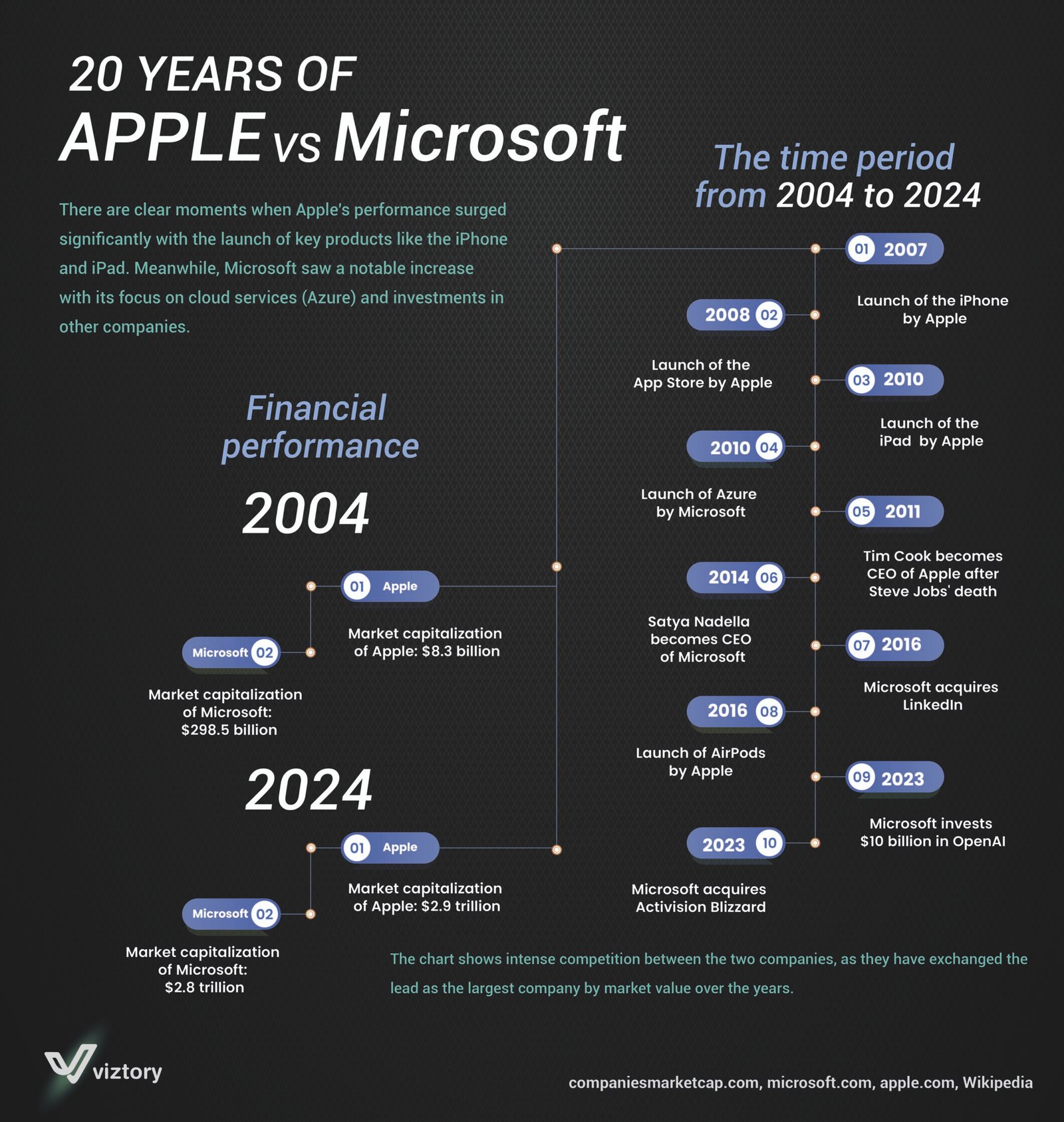Apple vs. Microsoft: A 20-Year Economic Journey (2004-2024)
-
Aug, Thu, 2024
Apple vs. Microsoft: A 20-Year Economic Journey (2004-2024)
The technological and financial rivalry between Apple and Microsoft has been one of the most defining narratives of the past two decades. This competition is clearly illustrated in the infographic, which traces the two tech giants’ key milestones and market performance from 2004 to 2024. As technology advanced, the market capitalization and strategic direction of both companies underwent significant transformations, reshaping not only their trajectories but also the broader economic landscape.
Financial Performance in 2004
In 2004, Microsoft was the dominant force with a market capitalization of $298.5 billion, while Apple lagged significantly behind at just $8.3 billion. This massive difference underscored the disparate positions of the two companies at the time: Microsoft was the established software titan, while Apple was known more for its niche in personal computing and creative industries.
Turning Points in Apple’s Growth
Apple’s remarkable growth can be traced back to several key product launches. The introduction of the iPhone in 2007 was the first major turning point, marking the beginning of Apple’s transformation from a computer company to a consumer electronics powerhouse. This was followed by the launch of the App Store in 2008 and the iPad in 2010, further cementing Apple’s role in reshaping consumer technology.
By 2024, Apple’s market capitalization had soared to an astounding $2.9 trillion. This exponential growth was fueled by innovation and a constant drive to expand its product ecosystem, with products like the iPhone, iPad, and AirPods playing pivotal roles. The success of Apple’s hardware products was complemented by the growth of its services segment, including the App Store, Apple Music, and iCloud.
Microsoft’s Response and Evolution
Microsoft’s trajectory, while different, also witnessed significant transformation. In 2010, the launch of Azure marked the company’s strategic pivot toward cloud computing, which would become a cornerstone of its growth strategy in the coming decade. Under the leadership of Satya Nadella, who became CEO in 2014, Microsoft aggressively expanded its cloud services and AI investments, positioning itself as a key player in the digital transformation of industries worldwide.
Despite the early lead Microsoft held in 2004, its growth wasn’t as explosive as Apple’s, but by 2024, it had achieved a market capitalization of $2.8 trillion. Microsoft’s strategic acquisitions, such as LinkedIn in 2016 and Activision Blizzard in 2023, along with its $10 billion investment in OpenAI, demonstrate the company’s efforts to remain competitive in key growth areas like gaming, professional networking, and artificial intelligence.
Key Economic Implications
The evolution of Apple and Microsoft has had profound economic implications, both for the companies themselves and for the broader tech industry. For Apple, its focus on creating a tightly integrated hardware and software ecosystem has allowed it to build a loyal customer base and generate significant revenue through high-margin services. The company’s growth has also played a crucial role in the global supply chain, influencing everything from component suppliers to retail channels.
Microsoft, on the other hand, has become a leader in the enterprise software market, with Azure’s growth reflecting the increasing importance of cloud infrastructure to businesses around the world. Microsoft’s investments in AI and its acquisition strategy also demonstrate a forward-thinking approach to maintaining its competitive edge in a rapidly evolving digital economy.
Market Leadership and Economic Shifts
Over the 20-year period, Apple and Microsoft have frequently traded the title of the world’s most valuable company. This intense competition reflects broader economic shifts, as technology companies have increasingly come to dominate global markets, surpassing traditional industries like oil and finance in terms of market capitalization. The rise of Apple and Microsoft symbolizes the shift toward a knowledge-based economy, where innovation, data, and digital infrastructure are central to growth.
Conclusion
The comparison between Apple and Microsoft over the past two decades highlights how both companies adapted to changing technological trends and economic conditions. While Apple capitalized on the consumer electronics revolution, Microsoft leveraged its dominance in enterprise software and cloud computing. Together, these two giants have shaped not only the tech industry but also the global economy, as their combined market capitalization in 2024 approaches $6 trillion. The competition between them underscores the ever-evolving nature of the tech industry and its far-reaching impact on economic growth and innovation.
Their journey reflects broader economic themes such as the rise of digital ecosystems, the importance of platform-based business models, and the growing influence of artificial intelligence and cloud services on the future of global markets.

